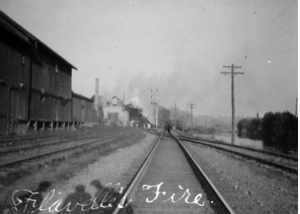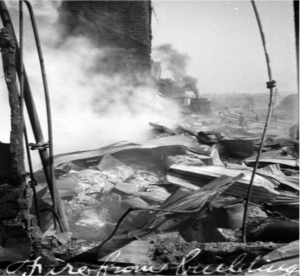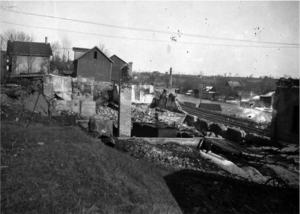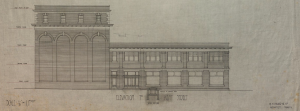Rebuilding After Loss: Lindsay Creamery and Cold Storage
There was a fire at the Lindsay Creamery and Cold Storage on October 5, 1916 with cause of origin undetermined. The fire commenced at some time prior to 5:00 a. m. and burned until the cold storage was nothing more than a pile of rubble by 2:00 p. m. that same afternoon. The following timeline account was assembled from the various newspaper accounts reporting the event.
Timeline of the Fire at the Cold Storage and Creamery
October 5, 1916:
5:00 a.m. — While butter makers separate the previous day’s cream, night watchman William Gray while walks the premises. Gray locates a fire in the boiler room and immediately sounds an alarm, and attempts to extinguish the flame – to no avail.
5:15 a.m. — Butter makers on the ground floor and cold storage staff at the east wing successfully evacuated.
5:30 a.m. — The building is engulfed in flames. Firemen arrive at the building.
5:45 a.m. — South winds threaten houses in the north-easterly part of town. Houses immediately opposite the plant catch fire. Residents of nearby houses use garden hoses and buckets of water to extinguish embers and prevent their roofs from catching fire as well.
6:00 a.m. — Eastern portion of building, including the creamery, is reduced to a pile of smoking debris.
8:00 a.m. — The ammonia plant explodes. An ammonia tank is hurled through the plant’s walls and lands across the river. The blast from the plant exploding is heard throughout the entire town.
8:30 a.m. — Fire reaches the lacteal plant, just west of cold storage, completely engulfing and destroying everything within that area. Brick chimney collapses.
9:00 a.m. — Fire spreads throughout the basement and moves upwards through the building. Produce in the cold storage catches fire.
9:30 a.m. — $250,000 worth of butter and cheese run down the river bank into the Scugog river, coating the surface for some distance.
11:00 a.m. — Firemen cut holes into sides of cold storage in an attempt to suffocate the blaze while streams of water are pumped in.
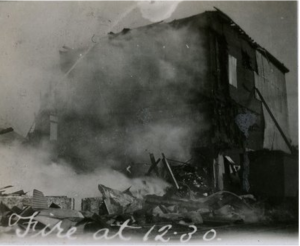
Western wing of cold storage at 12:30pm after firemen attempt to climb ladders to extinguish the flames. 1916.
12:00 p.m. — Increased air flow within the cold storage only feeds the fire, setting back hours of work.
2:00 p.m. — Cold storage is reduced to a pile of smoking rubble while firemen continue to direct streams of water on the premises for the duration of the day.
Time to Rebuild
The next day, October 6, 1916, using their organizational strength William and J. D. secured new creamery equipment from the De Laval Company of Peterborough. Utilizing their former creamery space in the Russell Street building which was now housing the Model Dairy’s company operations, butter manufacturing resumed only two days after the great fire.
The new creamery was designed by Toronto based architect George Miller and built on the corner of Kent Street and Victoria Avenue. The new building was made fireproof; using brick instead of wood, conduits for the wires and adding fire walls between the cold storage, work-rooms, creamery and office.
Flavelles Limited, already pioneers in cold storage, would soon become the largest and most modern storage in Canada and one of the largest creameries in Ontario.


